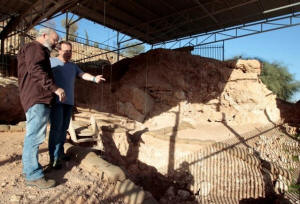|
 Prehistoric
man enjoyed roasted tortoise appetizers, Israeli archaeologist says Prehistoric
man enjoyed roasted tortoise appetizers, Israeli archaeologist says
 Send a link to a friend
Send a link to a friend
[February 02, 2016]
JERUSALEM (Reuters) - Prehistoric
cave-dwellers enjoyed munching on tortoises roasted in their shells as
an appetizer or side dish, Ran Barkai, an archaeologist at Tel Aviv
University, said on Tuesday.
|
|
 Barkai helped lead a research team who found 400,000-year-old
tortoise shells and bones in a cave in Israel that showed
hunter-gatherers butchered and cooked tortoises as part of a diet
dominated by large animals and vegetation. Barkai helped lead a research team who found 400,000-year-old
tortoise shells and bones in a cave in Israel that showed
hunter-gatherers butchered and cooked tortoises as part of a diet
dominated by large animals and vegetation.
Burn marks were found on the shells discovered in the Qessem cave,
as well as signs they were cracked open and cut marks indicating the
animal was butchered using flint knives.
"Now we know they ate tortoises in a rather sophisticated way,"
Barkai said. "It would have been a supplement - an appetizer,
dessert or a side dish - to the meat and fat from large animals."
 Qessem cave was uncovered during road work in 2000 and was believed
to be inhabited for about 200,000 years. The site has offered
scientists a rare insight into human evolution and accounted for
many research papers.
Bones scattered throughout the cave have already suggested a
calorie-rich prehistoric menu of horses, fallow deer and wild ox. A
study last year, based on plaque found on teeth, showed the cave's
inhabitants also ate plant-based material.
[to top of second column] |

The latest findings by Barkai's team, which included members from
Spain and Germany, were published this week in the journal
Quaternary Science Reviews.
(Reporting by Ari Rabinovitch; Editing by Jeffrey Heller and Raissa
Kasolowsky)
[© 2016 Thomson Reuters. All rights
reserved.]
Copyright 2016 Reuters. All rights reserved. This material may not be published,
broadcast, rewritten or redistributed.
 |